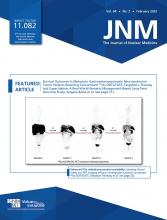Among the advances in radiopharmaceutical therapy, few innovations have shown more promise than targeted α-therapy. By inducing double-strand DNA breaks, high-linear-energy-transfer isotopes such as 213Bi, 212Pb, and 225Ac have the potential to produce substantially higher cytotoxicity than existing β-emitters (e.g., 177Lu). Indeed, since approval of 223Ra for castration-resistant prostate cancer metastatic to bone, there has been a 6-fold increase in the number of prospective trials of α-emitters.
In this issue of The Journal of Nuclear Medicine, Dr. Ballal and colleagues (1) have accumulated the largest real-world experience using targeted α-therapy in neuroendocrine tumor patients by radiolabeling DOTATATE with 225Ac in-house and treating patients with multiple cycles (≤10) at a dose of 100–120 kBq/kg per cycle. At the time of the most recent data analysis (cutoff, February 2022), 91 patients at the All India Institute of Medical Sciences had been treated with this therapy: a mixed population of patients who included peptide receptor radionuclide therapy (PRRT)–naïve individuals (n = 34), patients refractory to 177Lu-PRRT (n = 57), patients with progressive disease, and patients with stable disease but presumably treated because of symptom burden or tumor volume.
The results have been encouraging. At the time of analysis, median PFS had not been reached in the overall patient population and was reported to be 30 mo in patients who had received prior 177Lu-PRRT—patients who frequently do not exhibit long PFS intervals at the retreatment. Objective response rates were also impressive, at 44% both in patients who had received prior 177Lu-PRRT (25/57) and in those who were 177Lu-PRRT–naïve (15/34). No cases of myelodysplastic syndrome or acute leukemia have been reported as of yet, and treatment was described overall as tolerable.
Nevertheless, there are reasons to interpret these data with caution. The authors have, on occasion, described their work as a prospective phase II study (2). However, the term phase II study implies certain prerequisites, including a predetermined sample size, strict eligibility criteria, a clear prospective treatment protocol, and strict criteria for interpretation of response. These criteria do not apply to this analysis, which is best described as a retrospective study of real-world experience. The eligibility criteria seem to have shifted between the initial analysis of 32 patients in 2019 (3) and the current analysis. For example, exclusion of patients with a European Cooperative Oncology Group status of more than 2 (3) seems to have been unheeded (31% of patients were described as having status 3 or 4, which is, in itself, remarkable). Disease response and progression were evaluated using RECIST, version 1.1, despite the fact that many patients lacked contrast-enhanced anatomic imaging and were evaluated for response based on PET findings.
A notable revelation in this paper is that patients received capecitabine concurrently with 225Ac-DOTATATE. To our knowledge, this component of therapy was not reported in prior published analyses of the same patient cohort (2,3). While the contribution of radiosensitizing doses of capecitabine may have been minor, the display of this critical information is of the utmost importance to allow for reproducibility of the results.
Although many advances in nuclear medicine began with compassionate administration of in-house–radiolabeled drugs, drug approvals depend on prospective trials that are strictly followed. It is therefore fortunate that such trials are rapidly proliferating, including studies of targeted α-therapy for patients with neuroendocrine tumors. Examples are a phase II study of 212Pb-DOTAMTATE in 177Lu-PRRT–naïve and –refractory patients (NCT05153772) and a phase I/III study of 225Ac-DOTATATE in patients who have received prior 177Lu-PRRT (NCT05477576). If the outcomes are nearly as favorable as those described by Dr. Ballal et al., the future of targeted α-therapy in neuroendocrine tumors is promising.
DISCLOSURE
This work was supported in part by NIH grant P30 CA008748. Jonathan Strosberg is on the speakers’ bureau for Ipsen and Tersera. Ken Herrmann receives personal fees from Bayer, Sofie Biosciences, SIRTEX, Adacap, Curium, Endocyte, BTG, IPSEN, Siemens Healthineers, GE Healthcare, Amgen, Novartis, ymabs, Aktis Oncology, Theragnostics, and Pharma15; other fees from Sofie Biosciences; nonfinancial support from ABX; and grants from BTG, outside the submitted work. Lisa Bodei in a nonremunerated consultant for AAA-Novartis, Ipsen, Iba, Clovis Oncology, MTTI, and Great Point Partners. No other potential conflict of interest relevant to this article was reported.
Footnotes
Published online Oct. 20, 2022.
- © 2023 by the Society of Nuclear Medicine and Molecular Imaging.
- Received for publication August 16, 2022.
- Revision received August 22, 2022.







